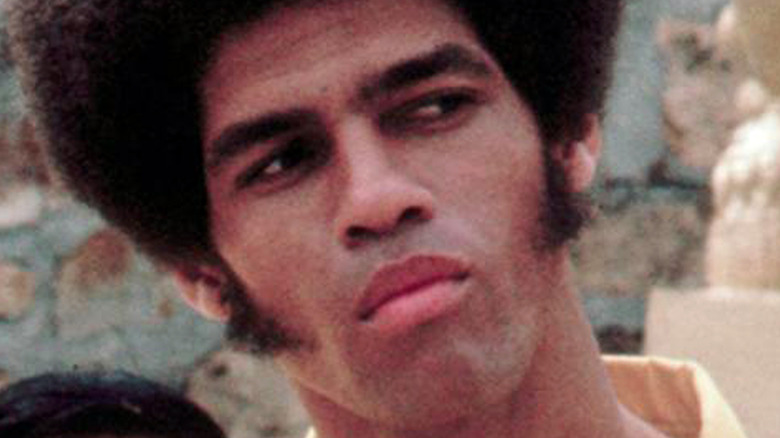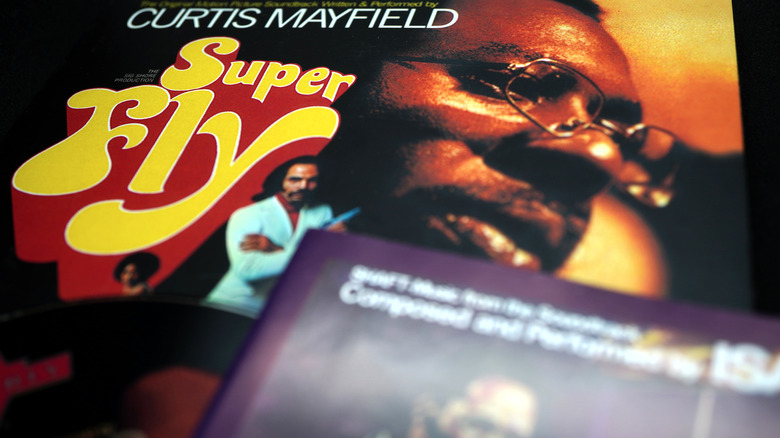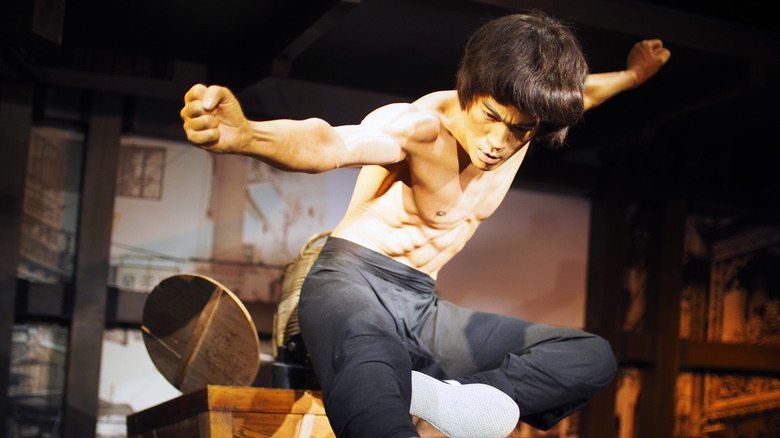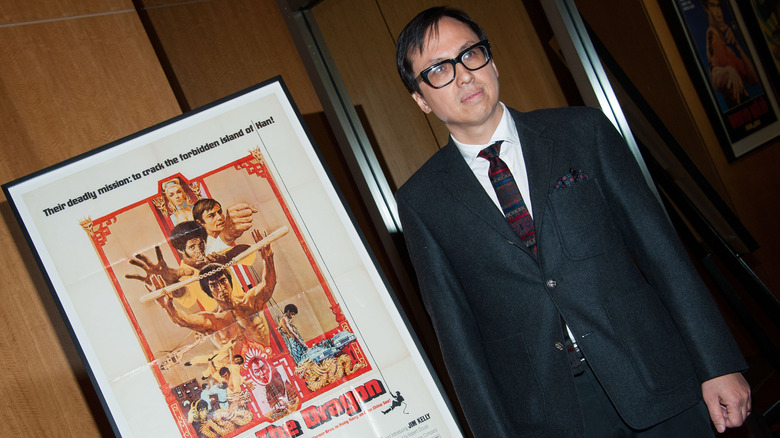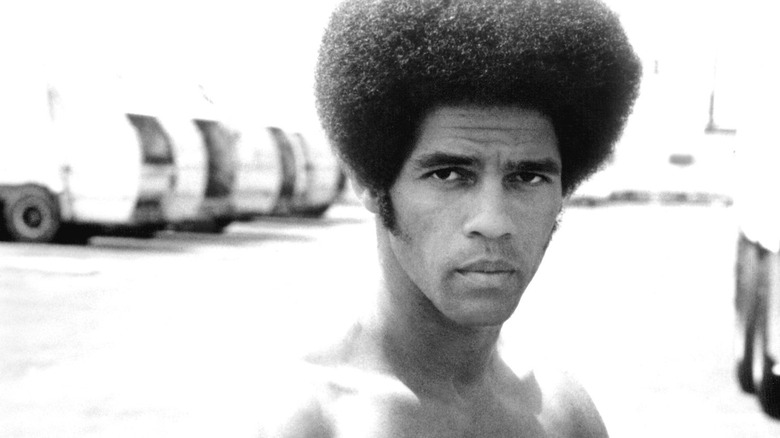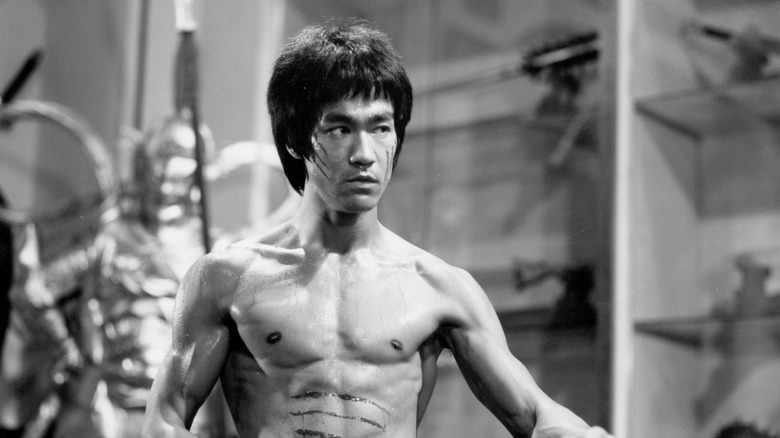How Bruce Lee's Last Film Helped Spawn The First Black Martial Arts Star
Who doesn't love a good kung fu movie? The genre is filled with many classics, but some, like the movies of Jackie Chan and Bruce Lee, might stand above others in terms of popularity and fame. Some people, however, might not be too familiar with how kung fu cinema came to be and its connections with another genre: blaxploitation.
The history of kung fu cinema and long and rich, going back all the way to the 1920s. Wu xia pian, which translates roughly to "martial arts movie," is the name for the martial arts genre that embodies kung fu action heroes and Chinese culture (via "The Global Return of the Wu Xia Pian: Ang Lee's 'Crouching Tiger, Hidden Dragon'" by Kenneth Chan). The genre was born in Shanghai back in the 1920s. The film "The Burning of the Red Lotus Temple" essentially exploded the popularity of the genre, leading to many more productions.
Bruce Lee, one of the biggest martial artists in history, had a tremendous impact on kung fu cinema itself. As Discovery explains, he helped popularize kung fu and even invented his own style called Jeet Kune Do. Lee did it all, and it's clear that his influence was felt across the world. But there's one other thing Lee did that some people might not know about: help launch the first Black martial artist.
What is blaxploitation
Blaxploitation is a film genre primarily directed toward Black film viewers, Black actors, and Black stories. As Britannica explains, notable movies of this genre include "Blacula," "Shaft," and "Buck and the Preacher." Oftentimes, these movies featured Black characters who had narrative autonomy and were often the heroes of their own stories. The most popular Blaxploitation movies tended to be action, which might explain why kung fu movies were also incredibly popular with Black audiences.
Blaxploitation was not without its critics. As Britannica says, the matter of Black stereotypes being used for easy cash-ins was of particular concern for many African American critics. Stereotypes such as drugs and violence were often a staple of Blaxploitation movies, and not everyone agreed with their portrayal. To this day, homages are still made of blaxploitation, and the genre is referenced by many directors, TV shows, and movies. As Vox notes, Marvel's Luke Cage has been seen by some as a love letter to the genre, and Quentin Tarantino's iconic film "Jackie Brown" is also a huge send-off.
How kung fu movies blew up in the United States
It's a fair assumption to say that martial arts movies are fairly popular in the United States. But some people might take this for granted, as martial arts movies weren't always the huge industry they are now. Before the explosion of kung fu, blaxploitation had been a huge staple among African American audiences. However, kung fu would soon also become a dominant genre within those communities. Blaxploitation sales suffered in 1972, which led to American movie studios producing more kung fu movies (via Polygon).
Early 1970s movies, such as "Fists of Fury," "Duel of the Iron Fist," and "Five Fingers of Death" helped blow kung fu cinema up to massive proportions in the U.S. As said by Polygon, 1973 was the year that basically started it all. And the first Black martial artist star to get big went by the name of Jim Kelly. Jim Kelly, being the first big Black name in kung fu cinema, was immensely important for African American representation, as he said n an interview with Black Belt magazine in 1992. His first movie was "Melinda" in 1972, followed by "Enter the Dragon" in 1973 with Bruce Lee (via IMDb). This was the film that launched his martial arts career and catapulted him to Black cinema stardom.
Bruce Lee's movie Enter the Dragon helped create a blaxploitation star
"Enter the Dragon" is one of Bruce Lee's most famous and beloved movies of all time. The 1973 film stars both Lee and Jim Kelly as martial arts masters who engage in an evil villain's kung fu tournament on a secret island, as IMDb says. The film was directed by Robert Clouse and went on to be included in the National Film Registry. The movie is considered to be one of the greatest and most important martial arts movies ever made and helped popularize the genre worldwide, as The Guardian notes.
In the film "Enter the Dragon," Kelly's role is that of a martial arts master, who eventually becomes a friend of Lee's character as they both attempt to stop the main villain of the film, Han. Kelly's role in the film was minor, but its impact was large (via Entertainment News). Afterward, Kelly got numerous roles in big blaxploitation staples, like "Three the Hard Way" and "Black Belt Jones." Kelly's career didn't end there, however, as he went on to star in a few other movies, too, such as "One Down, Two to Go" and "Black Samurai." Blaxploitation eventually did simmer down, and the genre is not as popular as it used to be, but its legacy still remains quite strong.
Jim Kelly was a professional martial artist in real life
Jim Kelly's importance in the martial arts genre cannot be understated. Not only was he one of the first Black martial artists to be on screen in America, but he also helped put Black acting and Black cinema on the map, so to speak. As The New York Times states, Kelly was also a martial artist in real life. This is an important detail, as many Black fighters at the time often were boxers and not martial arts masters. Kelly helped change that perception profoundly, introducing a whole new world of fighting to African American communities.
As The New York Times says, Kelly was a big star in both blaxploitation and martial arts, making him a big name in Black action cinema. He was first initially discovered by producers after establishing his own dojo. As Entertainment News says, Kelly often took part in Karate tournaments and eventually became a master after years of practice.
Jim Kelly and Bruce Lee had good on set chemistry
As said earlier, "Enter the Dragon" remains one of those influential movies that have stood the test of time. But what was it like on set for Bruce Lee and Jim Kelly? According to the Salon, they both got along famously. In an interview, Kelly talked about how Lee was quite inspirational for him and how working alongside him was a great experience. "It was one of the best experiences in my life," Kelly said. "Bruce was just incredible, absolutely fantastic. I learned so much from working with him. I probably enjoyed working with Bruce more than anyone else I'd ever worked with in movies because we were both martial artists. And he was a great, great martial artist. It was very good."
According to Black Belt, Kelly had "used karate as a steppingstone to get on the screen." To him, kung fu was his ticket into stardom, and it paid off tenfold. On top of his name being associated with one of the most famous martial artists in history, Kelly came out to be very accomplished in his own right. In another interview, Kelly speaks highly of Lee's sparring abilities, making it clear that the man himself lived up to his reputation. Lee and Kelly both may have passed, but their legacies will forever live on in celluloid.
